NEW SERIES
MEMORY AND THE MEDIEVAL NORTH
Jürg Glauser, Pernille Hermann, Stephen A. Mitchell, and Lena Rohrbach (eds.)
De Gruyter
First volume, click here.
Second volume out now, click here.
To read the flyer, please klick here: FLYER
Published
Memory and Remembering in Early Irish Literature. By Sarah Künzler.
Memory and the medieval north Volume 2. De Gruyter 2024, 298pp.
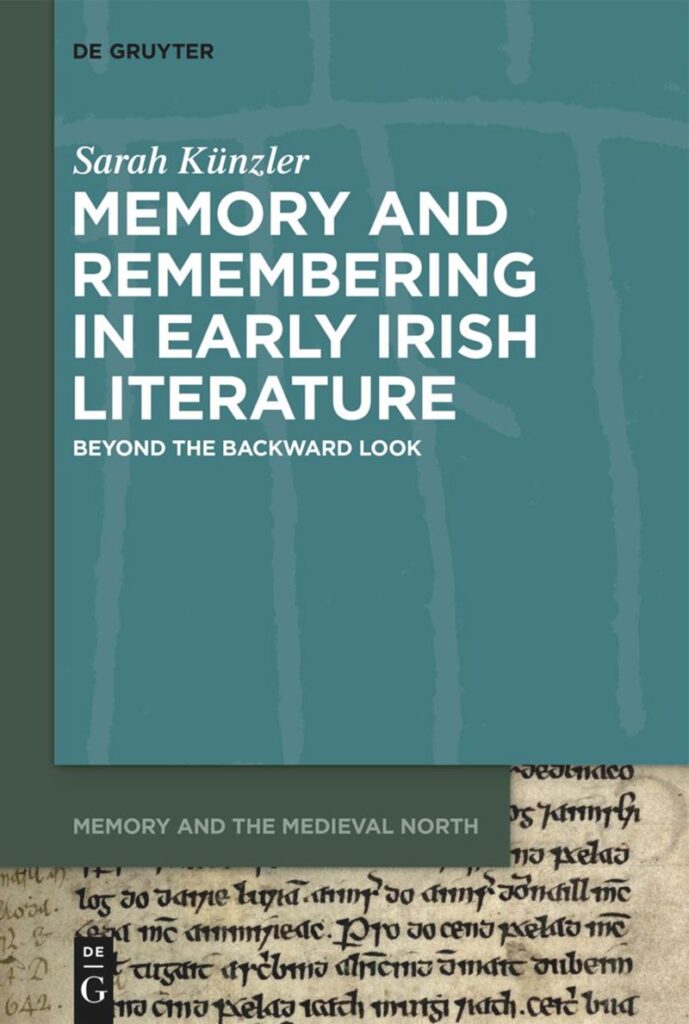
Abstract
Ireland possesses an early and exceptionally rich medieval vernacular tradition in which memory plays a key role. What attitudes to remembering and forgetting are expressed in secular early Irish texts? How do the texts conceptualise the past and what does this conceptualisation tell us about the present and future? Who mediates and validates different versions of the past and how is future remembrance guaranteed? This study approaches such questions through close readings of individual texts. It centres on three major aspects of medieval Irish memory culture: places and landscapes, the provision of information about the past by miraculously old eye-witnesses, and the personal, social and cultural impact of forgetting. The discussions shed light on the relationship between memory and forgetting and explore the connections between the past, present and future. This shows the fascinating spatio-temporal identity constructions in medieval Ireland and links the Irish texts to the broader European world. The monograph makes this rich literary sources available to an interdisciplinary audience and is of interest to both a general medievalist audience and those working in Cultural Memory Studies.
To purchase the volume click here.
To see the index of this volume click here.
Mnemonic Echoing in Old Norse Sagas and Eddas. By Pernille Hermann.
Memory and the medieval north Volume 1. De Gruyter 2022, 278pp.
Abstract
This book brings together Old Norse-Icelandic literature and critical strategies of memory, and argues that some of the particularities of this vernacular textual tradition are explained by the fact that this literature derives from, represents, and incorporates into its designs mnemonic devices of different kinds. Even if Old Norse-Icelandic manuscript culture is relatively silent about the mnemonic context of the literature, the texts themselves exhibit multiple reminiscences of memory. By showing that this literature reveals glimpses of mnemonic technologies at the same time as it testifies to a cultural memory, this study demonstrates how ‘the past’, and narrative traditions about the past, were constructed in a dynamic relationship with ideas that existed at the time the texts were written. Moreover, the book deals with the function of memory in early book-culture, with metaphors of memory, and with mnemonic cues such as spatiality and visuality. With its new readings of canonical texts like the Íslendingasǫgur, the Prose Edda and selected eddic poems, as well as of less widely studied branches of Old Norse-Icelandic literature, such as the sagas of bishops and religious texts, this book will be of interest to Old Norse scholars and to scholars interested in medieval Scandinavia and memory studies.
To purchase the volume click here.
To see the index of this volume click here.
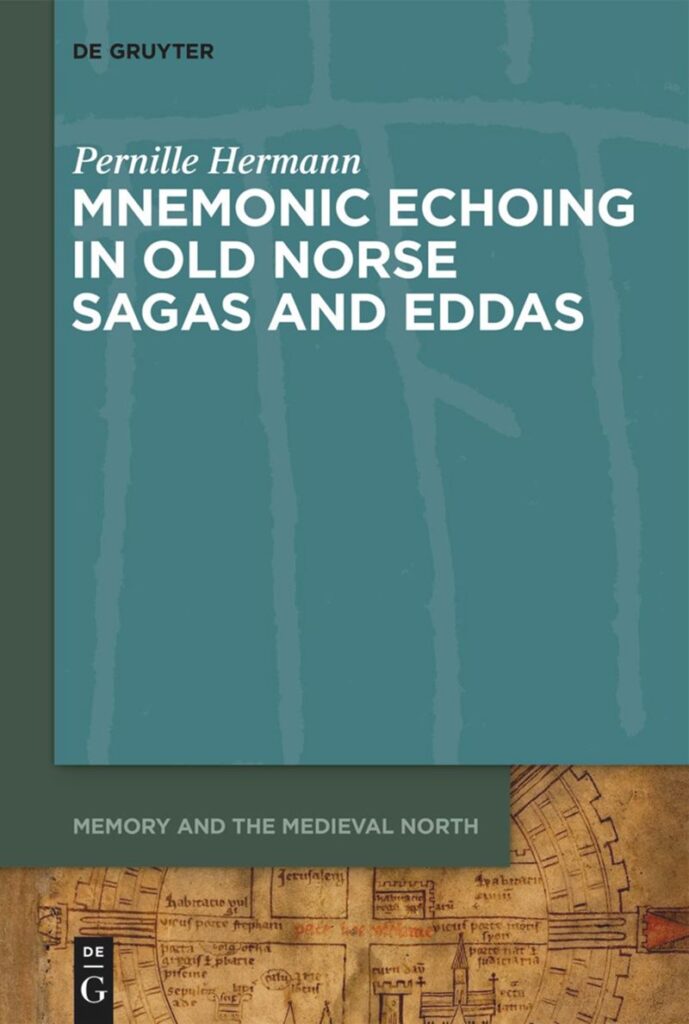
Medium Sagazeit – Eine literatursoziologische Annäherung an das ‚postklassische‘ Erzählen der Íslendingasaga im Spätmittelalter.
By Ellen E. Peters. Beiträge zur Nordischen Philologie. Narr Francke Attempto 2024, 480pp.
Beschreibung
Die sogenannten ‚postklassischen‘ Isländersagas wurden von der Sagaforschung lange vernachlässigt und als wertlose Nachahmungen abgewertet. Die Studie, die an die kulturwissenschaftlich ausgerichtete Sagaforschung anknüpft, entlarvt dies als Mythos in der Wissenschaft und zeigt auf, dass diese Erzählungen in der isländischen Allgemeinheit stets sehr populär waren, wie die klassischen Vertreter als glaubhafte Darstellungen der isländischen Sagazeit gelesen wurden und auch im kulturellen Erinnerungsprozess nicht minder bedeutsam sind. Im Spätmittelalter ist das kulturelle Erinnern jedoch unweit mehr von der sich zunehmend verbreitenden Schrift geprägt. Infolgedessen inszenieren die ‚postklassischen‘ Vertreter die Sagazeit medial, um so bedeutende identitätsstiftende Erinnerungen der Isländer zu vergegenwärtigen und zu aktualisieren, wie die Studie anhand zahlreicher Textbeispiele aus diversen Sagas veranschaulicht.
For more information and to purchase this Book click here.
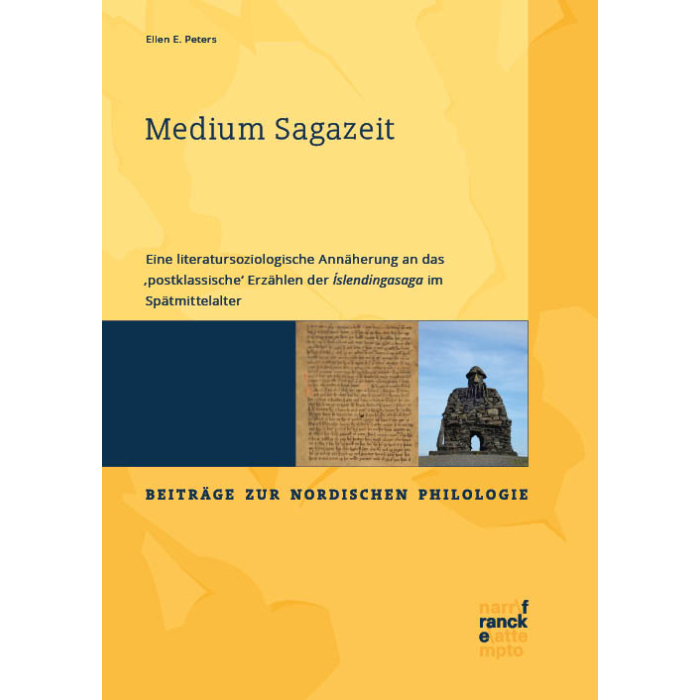
Old Norse Folklore – Tradition, Innovation, and Performance in Medieval Scandinavia.
By Stephen A. Mitchell. Myth and Poetics II. Cornell University Press 2023, 360pp.
ABSTRACT: The medieval northern world consisted of a vast and culturally diverse region both geographically, from roughly Greenland to Novgorod and culturally, as one of the last areas of Europe to be converted to Christianity. Old Norse Folklore explores the complexities of this fascinating world in case studies and theoretical essays that connect orality and performance theory to memory studies, and myths relating to pre-Christian Nordic religion to innovations within late medieval pilgrimage song culture.
Old Norse Folklore provides critical new perspectives on the Old Norse world, some of which appear in this volume for the first time in English. Stephen A. Mitchell presents emerging methodologies by analyzing Old Norse materials to offer a better understandings ofunderstanding of Old Norse materials. He examines, interprets, and re-interprets the medieval data bequeathed to us by posterity—myths, legends, riddles, charms, court culture, conversion narratives, landscapes, and mindscapes—targeting largely overlooked, yet important sources of cultural insights.
For more information and to purchase this Book click here.
Scandinavian-Canadian Studies / Études scandinaves au Canada 28, 2021, 318 pp.
Special Issue on Old Norse Studies and Collective Memory, Ed. Simon Nygaard and Yoav Tirosh.
ABSTRACT: This special issue of Scandinavian-Canadian Studies / Études scandinaves au Canada is the result of a number of sessions organized by guest editors Yoav Tirosh and Simon Nygaard for the 2018 International Medieval Congress (IMC) at Leeds and supported by the Memory and the Pre-Modern North network.
Contents: Dedication 11; Emily Lethbridge, “Foreword: Looking Back – and Ahead” 13-16; Emily Lethbridge “Avant-propos : Un regard sur le passé – et sur l’avenir” 17-21; Simon Nygaard, Yoav Tirosh, “Old Norse Studies and Collective Memory: An Introduction” 24-35; Jonas Koesling, “Memories Carved in Stones? Collective Memory Studies and Early Scandinavian Rune-Stones, or Remarks on the Banalities of ‘Burial-Stones’” 38-77; Andrea Marashi, “The Fimbulvetr Myth as Medicine against Cultural Amnesia and Hybris” 89-105; Deniz Cem Gülen, “The Forgotten King of Denmark – Haraldr II” 106-21; Ann Sheffield, “Remembering Heathen Women in Medieval Icelandic Literature” 122-43; Simon Nygaard, “ein lǫg ok einn siðr: Law, Religion, and their Role in the Cultivation of Cultural Memory in Pre-Christian Icelandic Society” 144-77; William Biel, “Memory of Iron: Object Rhetoric and Collective Memory in Laxdæla saga” 178-203; Santiago Barreiro, “Personal Memory, Family Memory, Collective Memory? The Parting Gifts in Egils saga, chapter 61“ 204-29; Sofie Vanherpen, “The Afterlives of an Icelandic ‘Foremother of Us All’: Auðr djúpauðga and the Making of Cultural Memory” 230-59; Vanessa K. Iacocca, “Saga-Sites of Memory: Jónas Hallgrímsson, Icelandic Nationalism, and the Íslendingasögur” 260-89; Lukas Rösli, “Memory, Trauma, and Cultural Semiotics – An Extensive Review” 292-310; Anna Solovyeva, “Jürg Glauser, Pernille Hermann, and Stephen A. Mitchell, eds. Handbook of Pre-Modern Nordic Memory Studies: Interdisciplinary Approaches“ 311-16; Sarah Künzler, “Ármann Jakobsson and Sverrir Jakobsson, eds. The Routledge Research Companion to the Medieval Icelandic Sagas“ 316-18;
Myth, Magic and Memory in Early Scandinavian Narrative Culture: Studies in Honour of Stephen A. Mitchell. Ed. by Jürg Glauser and Pernille Hermann, in collaboration with Stefan Brink and Joseph Harris. Turnhout: Brepols, 2021, 456 pp.
ABSTRACT: In this volume, several neighbouring disciplines, such as memory studies, literature, folklore studies, history of religion, medieval history, archaeology, oral history, and Old Norse studies intersect. The articles deal with similar questions and present illustrative case studies. Old Norse poems are analysed with regard to their mythological content; folktales, folklore, and other cultural phenomena are discussed with special foci on remembrance of the supernatural, witches, trolls, and others. One of the recurring questions is how we remember the past and how the past is created in memory.
Myth, magic, and memory have together formed important, and often intertwined, elements to recent studies in the narrative culture of Viking-Age and Medieval Scandinavica. Analytical approaches to myth (prominent in the fields of history of religion, archaeology, language, and literature, and central to studies of visual cultures up to modern times), magic (drawing on a wealth of Norse folkloric and supernatural material that derives from pre-modern times and continues to impact on recent practices of performance and ritual), and memory (the concept of how we remember and actively construe the past) together combine to shed light on how people perceived the world around them.
Taking the intersection between these diverse fields as its starting point, this volume draws together contributions from across a variety of disciplines to offer new insights into the importance of myth, magic, and memory in pre-modern Scandinavia. Covering a range of related topics, from supernatural beings to the importance of mythology in later national historiographies, the chapters gathered here are written to honour the work of Stephen A. Mitchell, professor of Scandinavian Studies and Folklore at Harvard University, whose research has heavily influenced this multi-faceted field.
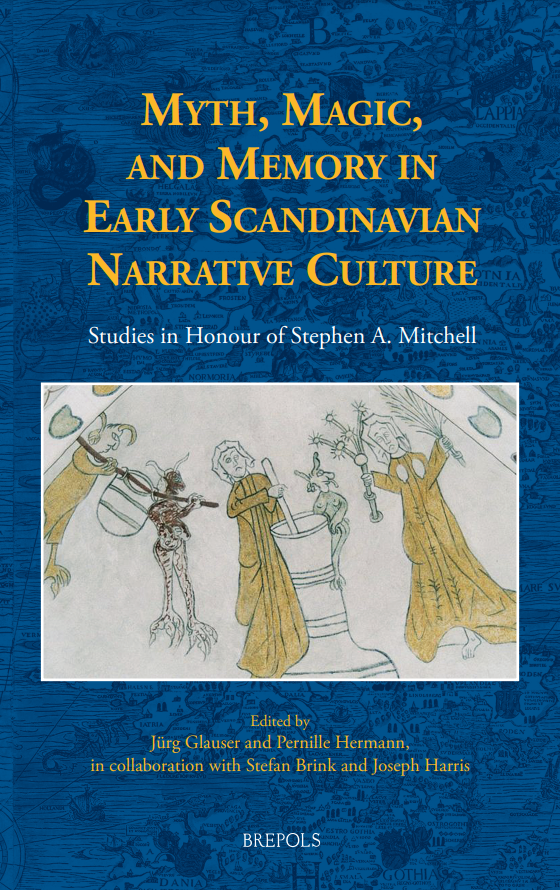
CONTENTS: List of Illustrations 9; Stefan Brink, Jürg Glauser, Joseph Harris and Pernille Hermann, “Foreword” 13;
Part I. Myth and Legend — John Lindow, “Same Place, Different Time: Temporal Aspects of Imagined Landscapes in Some Northern Contexts” 19; Jens Peter Schjødt,”Jarl, Konr, and Óðinn in Rígsþula” 33; Carolyne Larrington and Judy Quinn, “‘I remember giants’: Mythological Remembering through Vǫluspá” 47; Joseph Harris, “On Rereading Oddrúnargrátr” 63; Lukas Rösli, “The Agency in Fǫr Scírnis — Subjects, Objects, and Différance. A Subversive Reading” 77; Richard Cole, “The Threat of Induced Desire in Skírnismál” 91;
Part II. Magic and Folklore — Maria Tatar, “Enchantments, Spells, and Curses: The Sorcery of Stories and the Magic in Them” 113; Merrill Kaplan, “Trolls in the Mill: The Supernatural Stakes of Waterpower” 129; Joseph Falaky Nagy, “A Prophylactic Pig, a Long-Lost Hunter, and the Recording of Oral Tradition” 145; Sarah Künzler, “A Male Cinderella and a Sea-Serpent’s Teeth: Scandinavian Echoes in an Orkney Folk-Tale” 159; Terry Gunnel, “Axe on the Water. A Unique Magical Ritual in Ljósvetningasaga” 175; Ane Ohrvik, “‘In the Name of the 7 fatherless devils…’: Pain, Fear, Anger and Revenge in Magical Practice” 185; Thomas A. Dubois, “Lessons in Magic: Making Use of Early Twentieth-Century Accounts of Magical Procedures in the Folklore Classroom” 201; Timothy R. Tangherlini, “A Conspiracy of Witches” 217;
Part III. Memory and Reception — Kate Heslop, “Metaphors for Forgetting and Forgetting as Metaphor in Old Norse Poetics” 237; Lena Rohrbach, “Olavifications. Spatial and Temporal Formations of Trondheim as a Memory Place” 255; Anne Bugge Amundsen, “The Middle Ages in the Construction of Nineteenth-Century Norway” 271; Agnes S. Arnórsdóttir, “History and Cultural Memory in the Icelandic Annals 1400–1800” 287; Shaun F. D. Hughes, “Assembling Memory: The Questionnaire of 1817 from Den kongelige Commission til Oldsagers Opbevaring and the Origins of Icelandic Romantic Nationalism” 301; Kimberley C. Patton, “The ‘Asgard’ Superphylum and Lokiarcheaota: Mythic Relapse in Evolutionary Biology” 321;
Part IV. Influence and Interaction — Stefan Brink, “OGu vergildi and Välde in Etelhem, Gotland” 339; Anders Andrén, “The Judensau in Uppsala” 351; Louise Nyholm Kallestrup, “The Devil is Awake. Pre-Reformation Church Murals in Post-Reformation Danish Churches” 371; Pernille Hermann, “A Female Job and a Witch. High and Low in Leonora Christina Ulfeldt’s Jammers minde” 389; Jürg Glauser “O’Brazile: The Short Textual Life of a Floating Island in Seventeenth-Century Scandinavian Book History” 409; Lars Lönnroth, “Geijer och Eddornas ‘sinnebildsspråk’” 431; List of Stephen A. Mitchell’s Selected Publications 441; Index 449
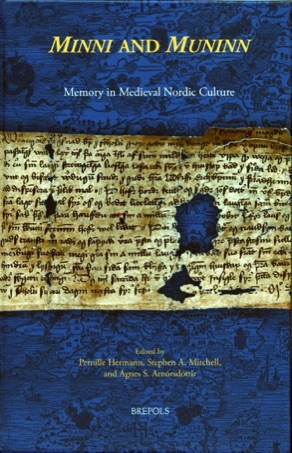
Minni and Muninn. Memory in Medival Nordic Culture. Ed. Pernille Hermann, Stephen A. Mitchell and Agnes S. Arnórsdóttir. Turnhout: Brepols, 2014, 254 pp.
ABSTRACT: Building on and applying the theoretical debates developed in Memory and Remembering: Past Awareness in the Medieval North, ed. Pernille Hermann and Stephen A. Mitchell, a special issue of Scandinavian Studies, 85:3 (2013), the articles in this volume deal with the vocabulary, concepts, and functions of memory in medieval Norse texts (e.g., sagas, myths, skaldic poems, laws, runic inscriptions, historiographical writings), with reference to international memory studies. Drawing on these emerging theoretical tools for studying—and conceptualizing—memory, the collection looks at new ways of understanding medieval cultures and such issues as transmission and media, preservation and storage, forgetting and erasure, and authenticity and falsity. Despite its interdisciplinary and comparative basis, the volume remains grounded in empirical studies of memory and memory-dependent issues as these took form in the Nordic world.
CONTENTS: Jürg Glauser, “Foreword” vii; Pernille Hermann, Stephen A. Mitchell, and Agnes S. Arnórsdóttir, “Introduction: Minni and Muninn — Memory in Medieval Nordic Culture” 1; Part I. Memory and Narration — Pernille Hermann, “Key Aspects of Memory and Remembering in Old Norse-Icelandic Literature” 13; John Lindow, “Memory and Old Norse Mythology” 41; Margaret Clunies Ross, “Authentication of Poetic Memory in Old Norse Skaldic Verse” 59; Kate Heslop, “Minni and the Rhetoric of Memory in Eddic, Skaldic, and Runic Texts” 75; Russell Poole, “Autobiographical Memory in Medieval Scandinavia and amongst the Kievan Rus’” 109; Part II. Memory and History — Rudolf Simek, “Memoria Normannica” 133; Stephen A. Mitchell, “The Mythologized Past: Memory in Medieval and Early Modern Gotland” 155; Gísli Sigurðsson, “Constructing a Past to Suit the Present: Sturla Þórðarson on Conflicts and Alliances with King Haraldr hárfagri” 175; Stefan Brink, “Minnunga mæn: The Usage of Old Knowledgeable Men in Legal Cases” 197; Agnes S. Arnórsdóttir, “Legal Culture and Historical Memory in Medieval and Early Modern Iceland” 211; Index 231
Memory and Remembering: Past Awareness in the Medieval North, Ed. Pernille Hermann and Stephen Mitchell. Special issue of Scandinavian Studies, 85:3, 2013, 149 pp.
ABSTRACT: The 2012 Radcliffe Seminar, “The Ambiguities of Memory Construction in Medieval Texts: The Nordic Case,” inspired a series of theoretically-oriented essays which appeared as Memory and Remembering: Past Awareness in the Medieval North. The authors of the essays in this special issue of Scandinavian Studies examine how a focus on memory, in combination with the various other methodologies and approaches that fill the intellectual kit bags of Scandinavian medievalists, alters our understanding of the Old Norse world and the cultural goods deriving from it. With a consideration of how Memory Studies can and should intersect with the diverse theories scholars use in cultural analysis, these essays examine memory’s crucial role in the construction of, and society’s preoccupation with, the past in the Nordic Middle Ages. Importantly, the discussions do not focus on problems of historicity, that is, what actually happened at some point in the past, but rather on how the past was constructed, valorized, recontextualized, re-enacted, and otherwise placed by each succeeding generation into a changed “contemporary” framework that gave the past meaning. With their focus on memory, the discussions in these essays challenge some of the most complicated debates in the study of the Nordic Middle Ages.
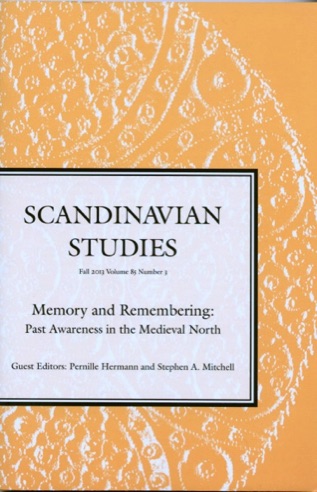
CONTENTS: Pernille Hermann and Stephen Mitchell, “Constructing the Past. Introductory Remarks,” 261-66; Anders Andrén, “Places, Monuments and Objects. The Past in Ancient Scandinavia,” 267-81; Stephen Mitchell, “Memory, Mediality, and the ‘Performative Turn’: Recontextualizing Remembering in Medieval Scandinavia,” 282-305; Thomas A. DuBois, “Ethnomemory: Ethnographic and Culture-Centered Approaches to the Study of Memory,” 306-31; Pernille Hermann, “Saga Literature, Cultural Memory and Storage,” 332-54; Bjørn Bandlien, “Hegemonic Memory, Counter-Memory and Struggles for Royal Power: The Rhetoric of the Past in the Age of King Sverrir Sigurðsson of Norway,” 355-77; Agnes S. Arnórsdóttir, “Cultural Memory and Gender in Iceland from Medieval to Early Modern Time,” 378-99; and Gísli Sigurðsson, “Past Awareness in Christian Environments: Source-Critical Ideas about Memories of the Pagan Past,” 400-10.